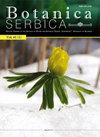塞尔维亚传统品种和野生梨:果皮和果肉的抗氧化、抗糖尿病和细胞毒活性之间的联系
IF 1.1
4区 生物学
Q4 PLANT SCIENCES
引用次数: 5
摘要
本研究旨在评价6个传统梨品种(Vidovaca、Lubenicarka、Karamanka、Jeribasma、Loncara和Takisa)、1个商品梨品种(Williams Bartlett)和1个塞尔维亚野生梨(Pyrus communis)果实的果皮、果肉、混合果皮和果肉甲醇提取物的抗氧化和抗糖尿病活性,以及混合果皮和果肉提取物的细胞毒活性。除黄芪和黄芪提取物外,所测试的提取物在防止-胡萝卜素漂白和-葡萄糖苷酶抑制方面表现出较强的抗氧化活性,没有显著的细胞毒性潜力。总的来说,最有效的水果部分是果皮。在所有应用的抗氧化和抗糖尿病试验中,最活跃的品种是竹梨,而野生梨(P. communis)在抑制癌细胞增殖方面最有效。总之,梨果实的几种甲醇提取物在预防和治疗与氧化应激相关的病理疾病(如糖尿病甚至结直肠癌)方面具有进一步的研究前景。本文章由计算机程序翻译,如有差异,请以英文原文为准。
Traditional varieties and wild pear from Serbia: A link among antioxidant, antidiabetic and cytotoxic activities of fruit peel and flesh
This study was aimed at evaluating the antioxidant and antidiabetic activities of methanolic extracts of peel, flesh and mixed peel, and flesh, as well as the cytotoxic activity of mixed peel and flesh extracts obtained from fruits of six traditional pear varieties (Vidovaca, Lubenicarka, Karamanka, Jeribasma, Loncara and Takisa), one commercial variety (Williams Bartlett) and a wild pear (Pyrus communis) from Serbia. The tested extracts showed strong antioxidant activity regarding the prevention of ?-carotene bleaching and high ?-glucosidase inhibition, and no significant cytotoxic potential, with the exception of the Williams Bartlett and Pyrus communis extracts. Overall, the most potent fruit part was shown to be the peel. The most active variety in all of the applied antioxidant and antidiabetic assays was Takisa, while the wild pear, P. communis, was the most effective in inhibiting the proliferation of cancer cells. In conclusion, several methanolic extracts of pear fruit are promising candidates for further studies regarding the prevention and treatment of pathological conditions associated with the effects of oxidative stress, such as diabetes and even colorectal cancer.
求助全文
通过发布文献求助,成功后即可免费获取论文全文。
去求助
来源期刊

Botanica Serbica
Agricultural and Biological Sciences-Plant Science
CiteScore
1.40
自引率
12.50%
发文量
17
审稿时长
34 weeks
期刊介绍:
Botanica Serbica publishes original research papers on all aspects of plant, fungal and microbial biology research including the disciplines of microbiology, mycology, lichenology, bryology, flora, vegetation, biogeography, systematics, taxonomy, plant biotechnology, plant cell biology, plant ecology, environmental plant biology, forestry, genomics, horticulture, limnology, metabolomics, molecular biology, proteomics, virology, plant conservation and protection, and wildlife and ecosystem management.
 求助内容:
求助内容: 应助结果提醒方式:
应助结果提醒方式:


